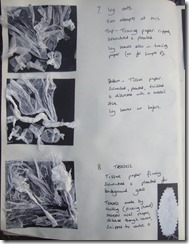Cas Holmes is one of the three artists we had to profile for this chapter and she has kindly left a comment on my blog advising me that she has not taught at Middlesex University some fifteen years ago.
Friday 13 January 2017
Module five. Chapter 3. Texture and relief in paper.
I have looked at my textured surfaces and photographs in chapter one to observe the textures and relief surfaces.
The following 9 samples correlate with those in chapter one; I’ve used suitable papers to achieve the desired effects:
Module five. Chapter 2. Relief paper investigations.
This chapter looks at using a collection of white papers with which to experiment by ripping, tearing, folding, scrunching and pleating in different ways.
1. Ripping and tearing; tearing on or against the grain produces a controlled or random effect respectively.
Then by folding and pleating with different weights and textures of paper I could create further interesting effects.
The examples below are arranged from the top left hand corner down to the bottom of the page and then 2nd row from top to bottom and so on:
2. Rip, fold and scrunch:
Nine different papers have been scrunched up to fit into a specific shape. Each paper started as an A4 size which has been scrunched up to fit a space one ninth of the original and mounted onto an A4 size piece of black card.
Different weights and textures of paper yield in various ways:
3. Manipulated tissue paper:
The translucency of tissue paper produced some fabulous effects:
4. Gathered and pleated samples of tissue paper which have been manipulated differently. All samples have been worked using a long stitch length on a sewing machine:












